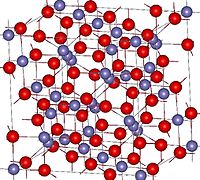Iron(II,III) oxide
 |
|
| Names | |
|---|---|
|
IUPAC name
iron(II) iron(III) oxide
|
|
| Other names
ferrous ferric oxide, ferroso ferric oxide, iron(II,III) oxide, magnetite, black iron oxide, lodestone, rust, iron(II) diiron(III) oxide
|
|
| Identifiers | |
|
1317-61-9 |
|
| 3D model (Jmol) | Interactive image |
| ChEBI |
CHEBI:50821 |
| ChEMBL |
ChEMBL1201867 |
| ChemSpider |
17215625 |
| ECHA InfoCard | 100.013.889 |
| PubChem | 16211978 |
| UNII |
XM0M87F357 |
|
|
|
|
| Properties | |
| Fe3O4 FeO.Fe2O3 |
|
| Molar mass | 231.533 g/mol |
| Appearance | solid black powder |
| Density | 5 g/cm3 |
| Melting point | 1,597 °C (2,907 °F; 1,870 K) |
|
Refractive index (nD)
|
2.42 |
|
Except where otherwise noted, data are given for materials in their standard state (at 25 °C [77 °F], 100 kPa).
|
|
|
|
|
| Infobox references | |
FeO.Fe2O3
Iron(II,III) oxide is the chemical compound with formula Fe3O4. It occurs in nature as the mineral magnetite. It is one of a number of iron oxides, the others being iron(II) oxide (FeO), which is rare, and iron(III) oxide (Fe2O3) also known as hematite. It contains both Fe2+ and Fe3+ ions and is sometimes formulated as FeO ∙ Fe2O3. This iron oxide is encountered in the laboratory as a black powder. It exhibits permanent magnetism and is ferrimagnetic, but is sometimes incorrectly described as ferromagnetic. Its most extensive use is as a black pigment which is synthesised rather than being extracted from the naturally occurring mineral as the particle size and shape can be varied by the method of production.
Under anaerobic conditions, ferrous hydroxide (Fe(OH)2) can be oxidized by water to form magnetite and molecular hydrogen. This process is described by the Schikorr reaction:
The well-crystallized magnetite (Fe3O4) is thermodynamically more stable than the ferrous hydroxide (Fe(OH)2 ).
Magnetite can be prepared in the laboratory as a ferrofluid in the Massart method by mixing iron(II) chloride and iron(III) chloride in the presence of sodium hydroxide. Magnetite can also be prepared by the chemical co-precipitation in presence of ammonia, which consist in a mixture of a solution 0.1 M of FeCl3·6H2O and FeCl2·4H2O with mechanic agitation of about 2000 rpm. The molar ratio of FeCl3:FeCl2 can be 2:1; heating this solution at 70 °C, and immediately the speed is elevated to 7500 rpm and adding quickly a solution of NH4OH (10 volume %), immediately a dark precipitate will be formed, which consists of nanoparticles of magnetite. In both cases, the precipitation reaction rely on a quick transformation of acidic hydrolyzed iron ions into the spinel iron oxide structure, by hydrolysis at elevated pH values (above ca. 10).
...
Wikipedia
